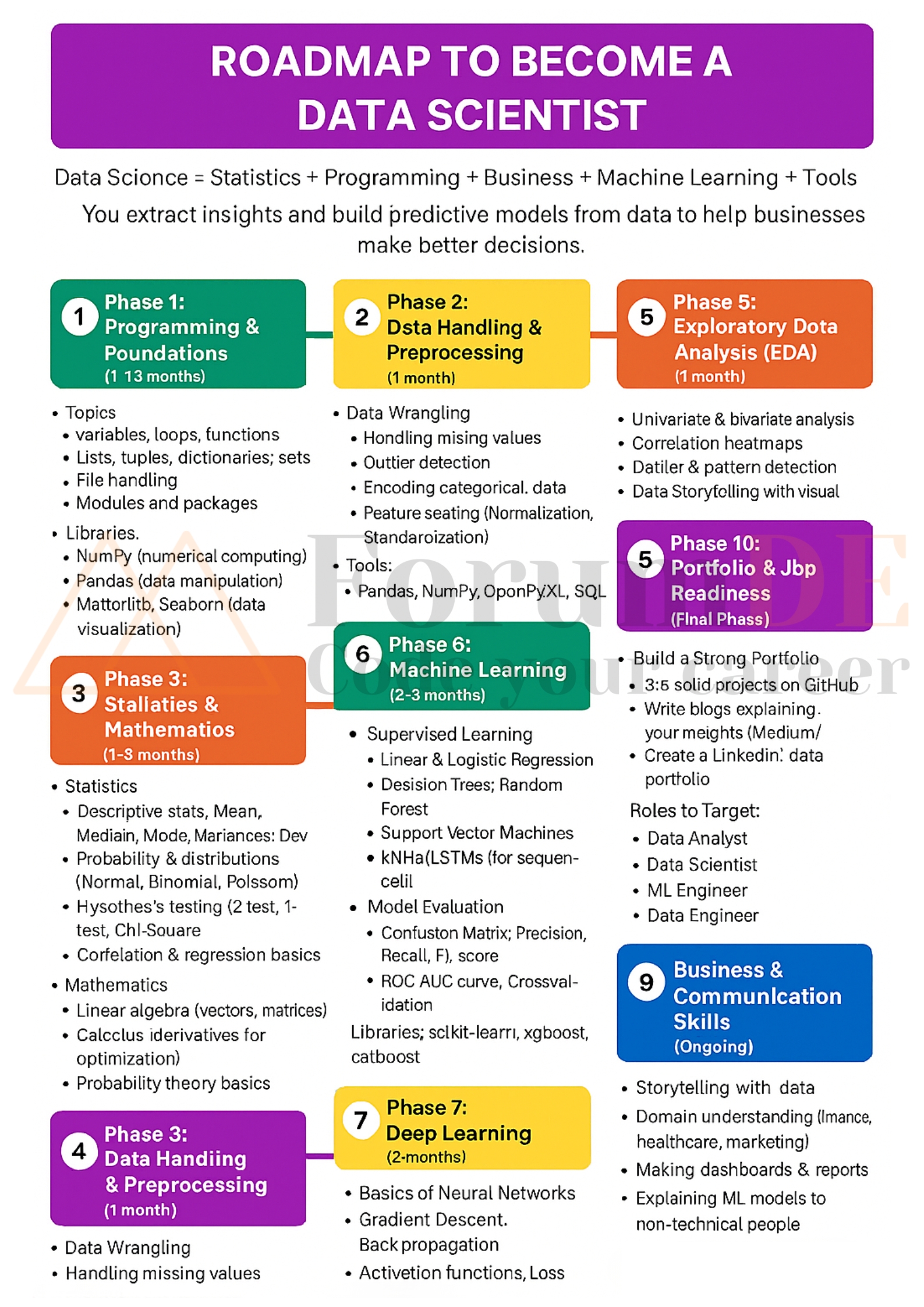📚 Chapters
Roadmap To Become Data Scientist
✍️ By Arun Kumar | 11/14/2025
Data Science = Statistics + Programming + Business + Machine Learning + Tools
You extract insights and build predictive models from data to help businesses make better decisions.

Data Science Learning Roadmap (2025)
Phase 1: Programming & Foundations (1–1.5 months)
Topics:
-
-
Variables, loops, functions
-
Lists, tuples, dictionaries, sets
-
File handling
-
Modules and packages
-
-
Libraries:
-
NumPy(numerical computing) -
Pandas(data manipulation) -
Matplotlib,Seaborn(data visualization)
-
-
Phase 2: Statistics & Mathematics (1–1.5 months)
Statistics
-
Descriptive stats: Mean, Median, Mode, Variance, Std. Dev
-
Probability & distributions (Normal, Binomial, Poisson)
-
Hypothesis testing (Z-test, T-test, Chi-square)
-
Correlation & regression basics
Mathematics
-
Linear algebra (vectors, matrices)
-
Calculus (derivatives for optimization)
-
Probability theory basics
Tools: Excel, Python (SciPy, statsmodels)
Phase 3: Data Handling & Preprocessing (1 month)
Data Wrangling
-
Handling missing values
-
Outlier detection
-
Encoding categorical data
-
Feature scaling (Normalization, Standardization)
-
Merging, joining, and grouping datasets
Tools
-
Pandas,NumPy,OpenPyXL,SQL
Phase 4: SQL for Data Science (1 month)
-
Basic queries:
SELECT,WHERE,GROUP BY,ORDER BY -
Joins, subqueries
-
Window functions, CTEs
-
Writing analytical queries
Phase 5: Exploratory Data Analysis (EDA) (1 month)
-
Univariate & bivariate analysis
-
Correlation heatmaps
-
Outlier & pattern detection
-
Data storytelling with visuals
Libraries: Matplotlib, Seaborn, Plotly
Phase 6: Machine Learning (2–3 months)
Supervised Learning
-
Linear & Logistic Regression
-
Decision Trees, Random Forest, XGBoost
-
Support Vector Machines (SVM)
-
k-Nearest Neighbors (kNN)
Unsupervised Learning
-
Clustering (KMeans, DBSCAN)
-
Dimensionality Reduction (PCA, t-SNE)
Model Evaluation
-
Confusion Matrix, Precision, Recall, F1-score
-
ROC-AUC curve, Cross-validation
Libraries: scikit-learn, xgboost, catboost
Phase 7: Deep Learning (2 months)
-
Basics of Neural Networks
-
Gradient Descent, Backpropagation
-
Activation functions, Loss functions
-
CNNs (for images)
-
RNNs, LSTMs (for sequences)
-
Transformers (for NLP)
Libraries: TensorFlow, Keras, PyTorch
Phase 8: Real-World Tools & Projects (2–3 months)
Tools:
-
Version control: Git + GitHub
-
Data visualization: Power BI / Tableau
-
Big Data: Spark / PySpark
-
Cloud: AWS / GCP / Azure
-
MLOps: MLflow, Docker, Airflow
Projects (Portfolio builders):
-
Customer Churn Prediction (ML)
-
Stock Price Prediction (DL)
-
Sentiment Analysis (NLP)
-
Recommendation System
-
Fraud Detection
-
EDA on Real Datasets (Kaggle)
Phase 9: Business & Communication Skills (Ongoing)
-
Storytelling with data
-
Domain understanding (finance, healthcare, marketing)
-
Making dashboards & reports
-
Explaining ML models to non-technical people
Phase 10: Portfolio & Job Readiness (Final Phase)
Build a Strong Portfolio
-
3–5 solid projects on GitHub
-
Write blogs explaining your insights (Medium/Kaggle)
-
Create a LinkedIn data portfolio
-
Mock interviews & resume prep
Roles to Target:
-
Data Analyst
-
Data Scientist
-
ML Engineer
-
Data Engineer
-
Business Intelligence Analyst
Suggested Learning Timeline (Total ~8–10 months)
|
Data Source:
-
-
Kaggle
-
💬 Comments
Comments (0)
No comments yet. Be the first to share your thoughts!